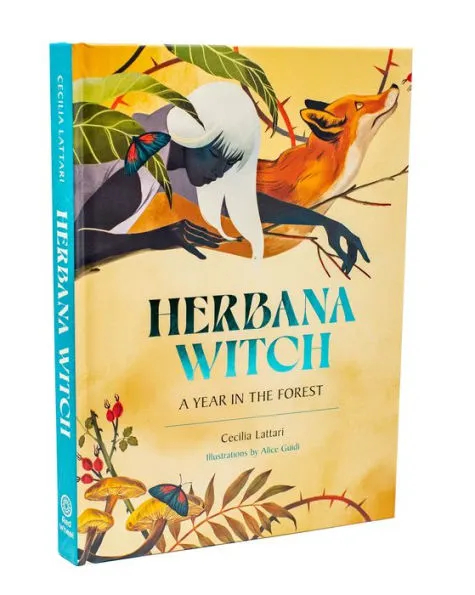I might call this a coffee table book because it’s beautifully rendered and fun, and because it seems meant to be displayed and shared with friends. But it’s more than a coffee table book, and it’s neither big, nor expensive, nor showy. Instead, it’s a set of lessons.
Herbana Witch is organized around the four seasons, featuring lore about plants and instructions for doing and making things in sync with winter, spring summer, and fall.
An herbana witch may live near a forest as author Ceilia Lattari does, or in an urban location, revering nature just as much. An herbana witch is someone who lives on the edge, in “a space on the threshold, a place of possibility, where we can see things from a different perspective…. The edge is thus a space that stands in opposition to the tenets of the majority.”
This kind of different perspective comes to mind now as I’m reading this book in the winter season in Earth’s northern hemisphere. Mainstream society promotes a hurry-up attitude about getting things done before the end of the calendar year. Nature’s got a different perspective. “In winter,” Lattari writes: “do as the forest does: rest.”
In her section on winter, Lattari honors the oak tree. It’s “majestic and old, a threshold tree between autumn and winter.” She’s got a recipe for making bread out of ground up acorns, another one for making a respiratory balm using essential oil of pine, another for a winter incense and for candles made out of soy wax. Winter’s totem animal is Wolf, an edge being, familiar like a dog, but also unfamiliar and wild.
By spring it’s time for things to sprout, time of the fertile hare, time to hear and observe with one’s senses, including intuition, the sixth sense. At summer, it’s time to nurture, to “exercise willpower and precision, and learn how to receive things wholeheartedly, filling yourself with sunshine and radiance.” By autumn, it’s time again to slow down. Plants in autumn focus their energies on their roots. In the fall, one gathers and ferments.
Lattari teaches that knowing “signatures” is key to working with the seasons. It’s “the art of knowing how to observe the signs and symbols of the natural world, and connecting them to humans, to find healing relationships, find balance and heal,” Lattari writes. “The herbana witch is the goddess of small things.” She gives the example of the St. John’s Wort plant. Its signature is leaves that look like they’re perforated, and it’s a plant for healing wounds.
Resting, sprouting, nurturing, gathering-- round and round with the months-long seasons of one’s own locale. You can read Herbana Witch as a kind of cook book for doing things in sync with Nature’s cycles. All the ways of doing, though, are also ways of being, day by day, in any season.
~review by: Sara R. Diamond
Author: Cecilia Lattari
Red Wheel/Weiser, 2023
160 pages, $18.95

